Why is it Important to Read the Label?
Reading the pesticide label is key to making sure you’re purchasing the correct product and also applying it in a way that protects you, your children and pets and the environment.
In this article we cover some tips for considering when to use a pesticide and the basics of reading pesticide labels.
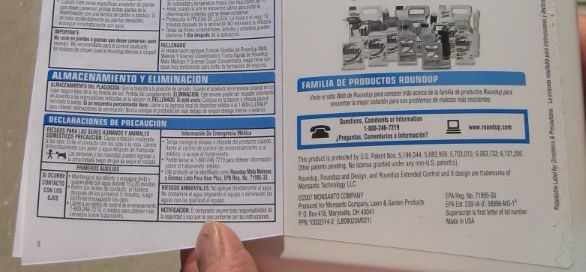 A pesticide label with a peel back tab that reveals additional instructions.
A pesticide label with a peel back tab that reveals additional instructions.
Caption: An example pesticide label with a peel back tab that reveals additional instructions. Note: Trade-name products and services are mentioned as illustrations only. This does not mean that the UNR Extension either endorses these products and services or intends to discriminate against products and services not mentioned. Credit: Sue Donaldson
What to Know Before Using a Pesticide
Before using a pesticide, there are some key things to consider:
- Identify the problem – it might not be a pest!
- Your plants could be struggling for many reasons. It could be something other than a pest, such as a nutrient deficiency or drought stress. In these cases, a pesticide won’t solve the problem.
- Prevention is the best cure.
- Look at the underlying causes and consider if there are things you could do differently to prevent pests. For example, using mulches can prevent weeds and reduce the need to use a weed killer. Using a pesticide may seem like a quick fix, but it is often only a temporary solution, which leads to more time and money spent in the long run.
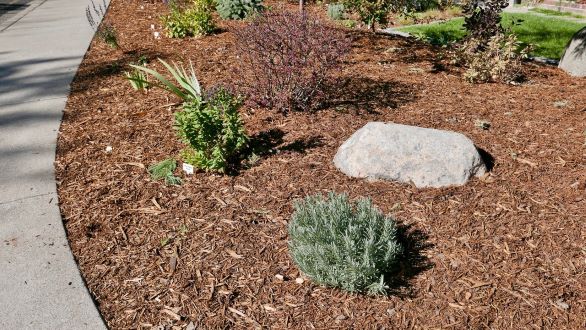
Caption: Mulches, like the wood bark mulch shown here, prevent pests and reduce maintenance. They prevent weeds from coming up, protect against erosion and help to conserve soil moisture. Credit: Carrie Jensen
- Only use pesticides when they are really needed.
- There may be mechanical control methods to consider first. For example, aphids can usually be controlled by washing them off with a strong spray of water rather than using a pesticide.
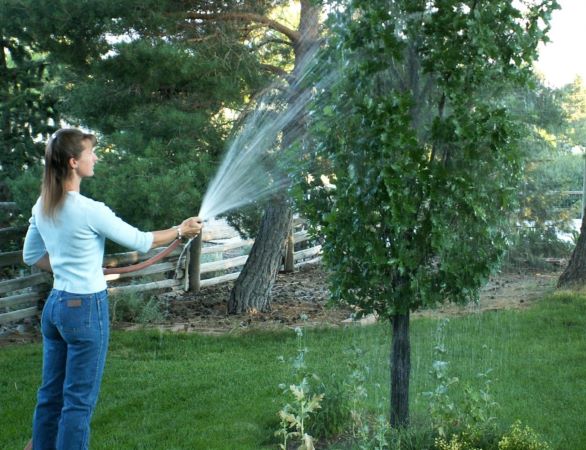
Caption: Aphids are soft-bodied insects that can easily be washed off with a hose and spray nozzle. Credit: Sue Donaldson
- Choose the correct product for your problem.
- Always choose the least toxic option for your needs.
- Read and understand the entire label before deciding to use a product.
Pesticide Labels Include the Following Information
Pesticide labels include a lot of information, and you are legally required to read, understand and follow ALL the instructions. Let’s look at the basic information that is included:
- Brand Info: Name of the product (Note that products with similar brand names can have different active ingredients.)
- Child Hazard Statement: Keep out of the reach of children
- Ingredients: Active and inactive ingredients
- Signal Words: How toxic is this product?
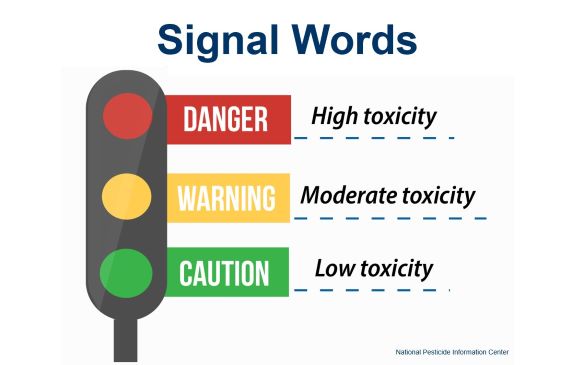 Signal words on pesticide labels include caution for low toxicity, warning for moderate toxicity, and danger for high toxicity.
Signal words on pesticide labels include caution for low toxicity, warning for moderate toxicity, and danger for high toxicity.
- Net Contents: How much is in the container?
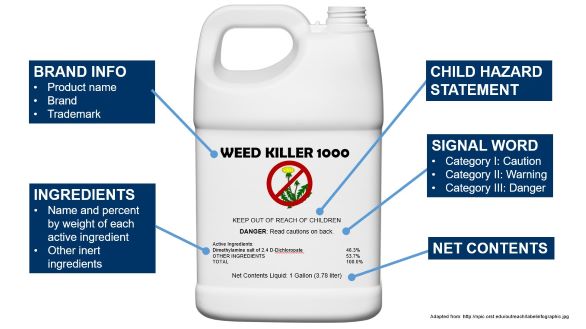 Typical information shown on the front of a pesticide container includes brand information, ingredients, a child hazard statement, signal words indicating toxicity and the net contents.
Typical information shown on the front of a pesticide container includes brand information, ingredients, a child hazard statement, signal words indicating toxicity and the net contents.
Typical information included on the front of a pesticide container. Credit: Carrie Jensen
- Precautionary Statements: How can the product be used safely?
- First Aid Information: What should I do if I or someone else gets the product in their eyes, drinks it, breaths it in or gets it on their skin?
- Personal Protective Equipment: What should I wear to protect myself during application?
- Directions for Use: How, where and how much of the product should I use?
- Storage and Disposal: Where do I store the product, and what do I do with leftovers?
- Manufacturer’s Contact Information: Who can I contact for more information?
- EPA Registration Number: What is the product’s unique number?
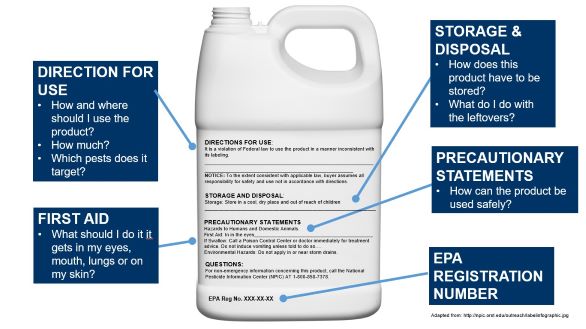 The typical back of a pesticide container may include directions for use, first aid information, storage and disposal instructions, precautionary statements, and the EPA registration number.
The typical back of a pesticide container may include directions for use, first aid information, storage and disposal instructions, precautionary statements, and the EPA registration number.
Typical information included on the back of a pesticide container. Credit: Carrie Jensen
For more information on how to apply pesticides safety, see our video.
This material is based upon work supported by the National Institute of Food and Agriculture, U.S. Department of Agriculture, under Award No. 2021-70006-35488. Any opinions, findings, conclusions, or recommendations expressed in this publication are those of the author(s) and do not necessarily reflect the view of the U.S. Department of Agriculture.


